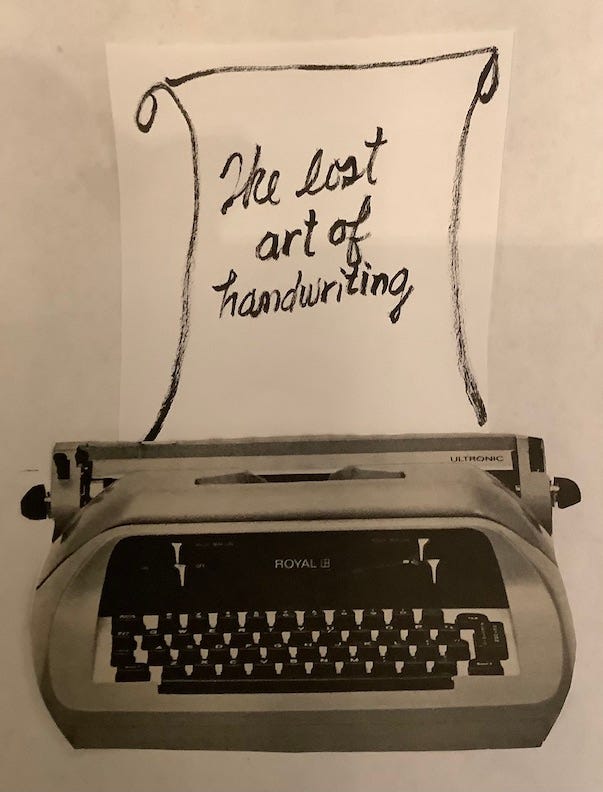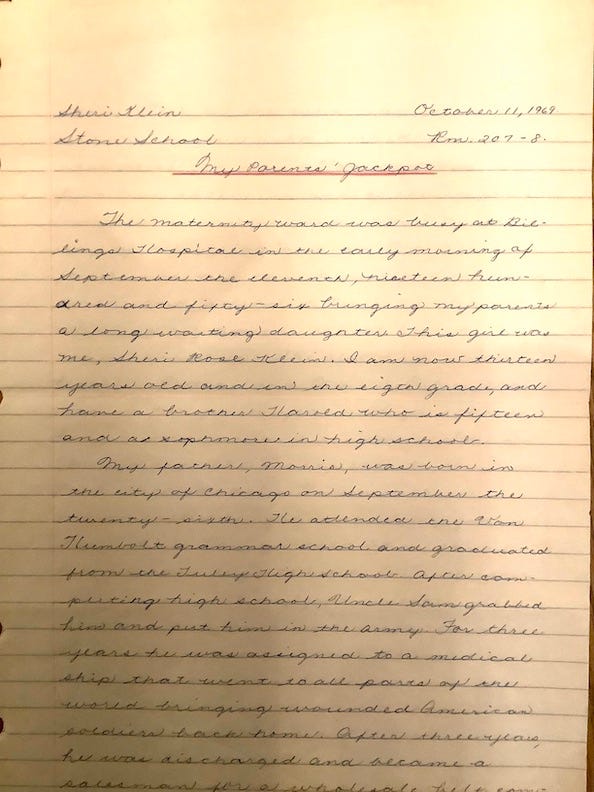When my grandmother emigrated to the US in the early 20th century, she could not read English, but she could write her name. Writing your name was and is still a big deal as all important documents still require a handwritten signature.
Handwriting is the act of forming letters and words using one’s hand holding a pen, pencil, or other writing instrument. Cursive handwriting are words written in a flowing (cursive) manner, which connects many or all of the letters in a word.
Forming letters is considered basic and critical to child development and developing hand-eye coordination. The outcomes of handwriting activity are known to activate more brain areas, advance motor skills, and increase the retention of ideas.
As a child, I was taught cursive handwriting and printing in school. In grade school, we practiced writing often on lined worksheets. I loved to print my name and write letters. When I was six years old, I wrote this letter to an aunt in California (my parents photocopied it). It gave me a wonderful opportunity to practice printing, spelling and learn more about the art of letter writing.
I developed a near perfect handwriting—that is—well-formed letters that were spaced well and fit snugly on the lined paper between the margins. In the 7th grade, we were assigned to write a paper about our family. My handwriting is consistently neat and even throughout my four page paper and reflects the care I brought to this writing assignment.
In the 1960s, when I was an elementary student, the Chicago Public School classrooms had slate blackboards with three painted lines at the top. Every Friday afternoon, I was asked to wash the boards in my homeroom and replace the existing alphabet. I stood on an oak chair and carefully formed each capital letter followed by a lowercase letter in cursive script using white chalk.
A unique distinction of handwriting is penmanship, or the art or skill of writing by hand. If you have really good handwriting you are said to have ‘good penmanship.’ Penmanship involves bringing an aesthetic awareness and beauty to the printing or cursive handwriting process. Platt Rogers Spencer, considered the father of American penmanship, published his Spencerian penmanship manuals in the mid 19th Century. Other models soon followed such as, the Palmer, Zaner-Bloser and D’Nealian methods. You can still purchase Spencerian penmanship manuals today. Mid 20th century writing methods began to include what is known as manuscript printing, or the combination of capital letters and lowercase, using a less time consuming method. Those who worked in 19th century and early 20th century offices and business relied upon having excellent penmanship necessary for keeping ledgers, writing letters, and legal documents. Good or excellent penmanship has qualities of: legibility, even consistency to the ink, well-spaced and well-formed words, and a pleasurable balance of words on the page.
Times have changed with texting and keyboard tools for writing. While organizations like the National Handwriting Association advocate for handwriting skills as central to the development of children, and contests continue to award beautiful penmanship, very few US school districts now require the teaching of cursive handwriting.
Holiday cards can now be ‘signed’ with digital/printed text, and iPhone apps can generate shopping lists. It’s interesting that in these current times the annual sales of stationary (greeting cards, papers, etc.) is 6+ billion dollars! A quick Google search of fine stationary includes a plethora of options to purchase customized notecards on high quality stationary papers with trends that suggest a demand for fancy stationary and the purchase of fountain pens as gifts.
Perhaps cursive writing is not dead afterall.
Handwritten letters and documents using pen and ink and paper are part of our personal, political, social and literary histories. Letters to and from politicians, artists and writers bear details, insights, nuances, and emotional content that biographers and historians rely upon to construct a narrative of a life. Handwritten cards and letters from family and ancestral members are important historical documents and artefacts that help us to understand relationships and family histories. I read a story once about a guy in Vietnam whose life was saved from a bullet because had all the letters from his girlfriend tucked in his shirt over his chest. Handwritten letters can save lives, too.
In your experience—
Is handwriting a lost art?
Is cursive handwriting a necessary skill today?
Do you still write thank you notes or letters to friends or family?
What do you think of your handwriting?
Would love to hear your thoughts!







